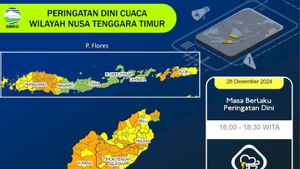YOGYAKARTA - The Section for Maintenance of Benda Cultural Heritage, the Center for Cultural Heritage Maintenance and Development and the Section of the Yogyakarta Special Region Culture Service (DIY) found ancient waterways.
This finding was combined during excavation or archaeological excavation of the western side of Kedaton IV at the Pleret Palace Site, Bantul Regency, DIY.
"The team of archaeologists found ancient waterways (paralons) made of clay which the community called plemples or ripples. At least eight ancient clay pellets were found in the western side of the Kedaton IV excavation area," said EXcavation Expert of the DIY Culture Service Danang Indra Prayudha when confirmed in Bantul, Antara, Tuesday, March 14.
According to him, the ancient water channel found in the Kedaton IV excavation process approaching the last day had a length of at least 62-66 centimeters with a diameter of 35 centimeters per real.
He explained that the water channel was initially found at the westernmost cut on Wednesday, March 8 afternoon before the end of the excavation hour. When found it was not fully visible in the shape of a cylinder, it was only the impact of the surface.
Then on Thursday, March 9, the team tried to fully open the findings of the pottery because it suspected that there was a canal to the east and the findings of the two westernmost pieces in the form of a cylinder were opened.
"After learning that it was a cylindrical-shaped pottery, we tried to find the canal to the east again. On Friday all day and Monday we found a water channel as we can see at this time," he said.
However, he said, the ancient waterways found would still be further identified, especially regarding the function of whether to drain water or clean waterways.
From the initial hypothesis, the team suspected that this ancient water channel was in a context with a fort on the west side of the palace. The next hypothesis is that the fort has a channel from inside and outside that stops at the mouth of the inner side of the fort, inside the canal fort it is replaced with white bricks stacked with red bricks until the fort comes out. there is a mouth channel.
"This is the first and unique new finding because there are waterways. We suspect this is a period but still needs to be proven. But in the meantime this is part of the fort because the slope is the same and the part is integrated between the fort and its water channel," said Danang.
He said if it turned out that this water channel was indeed part of the fort, it would show the fort had a water channel, and his party would test the soil samples in the canal, whether it was dirt or clean water.
The English, Chinese, Japanese, Arabic, and French versions are automatically generated by the AI. So there may still be inaccuracies in translating, please always see Indonesian as our main language. (system supported by DigitalSiber.id)
Tags les plus populaires
#Prabowo Subianto #Nouvel An #pdip #Hasto Kristiyanto #nataru #NatalPopulaire
28 Desember 2024, 09:43









